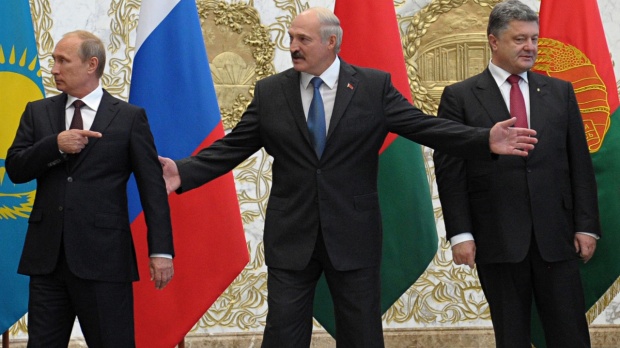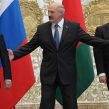
Putin Weighs Conflict Escalation and De-Escalation Options
Publication: Eurasia Daily Monitor Volume: 12 Issue: 27
By:

German Chancellor Angela Merkel and her French counterpart, Francois Hollande, have been leading intense diplomatic efforts to de-escalate the crisis Ukraine. Yet, as Russian media reported, the Merkel-Hollande summit with Russian President Vladimir Putin on February 6, in Moscow, following their trip to meet President Petro Poroshenko in Kyiv stemmed from a nine-page document from Putin setting out the basis of a lasting settlement. Advances made in Donbas (eastern Ukrainian region encompassing the provinces of Luhansk and Donetsk) by Russia-backed rebels, discussions in Washington about supplying lethal defensive arms to Ukraine, as well as other factors appear to have galvanized Merkel into action (Vedomosti, February 8).
Russian state television seized on Western media reports that Hollande had characterized the meeting with Putin as being linked to the possible plans by the United States to arm the Ukrainian Army. These reports also stressed the Merkel-Hollande proposals as based upon the nine-page document from Putin. Moreover, typical of Russian media coverage, the emphasis was on Putin’s January 15 peace proposal—which Poroshenko rejected. In other words, the tone of the coverage was to cast Putin as a peacemaker (Channel One, Rossiya 1, NTV, February 6).
Picking up on some of these themes, Russian presidential aide Yuriy Ushakov said the German and French leaders had undertaken their Moscow trip in response to conflict escalation since January 15, and noted that Putin had made several efforts to de-escalate. According to Ushakov, Moscow sought “overall stabilization” in Donbas, the establishment of direct contact between Kyiv and the rebel leadership, and the restoration of economic ties between “Ukraine” and the “southeast of the country” (Vedomosti, February 6).
As these events unfolded, and the situation in Donbas deteriorated, Washington published the 2015 US National Security Strategy. Initial Russian media coverage noted only a few aspects of the new strategy. However, the Russian leadership can hardly fail to note the removal of the positive language of the “reset” from the 2010 strategy, replaced by several negative references to Russian actions, including the phrase “Russian aggression” (Rg.ru, Gazeta.ru, February 6).
As the diplomacy intensified with preparations for the February 11 Minsk summit, Russian media coverage highlighted clear divisions between the US and European governments on the issue of lethal defensive arms; Merkel and Hollande were flatly against stoking the conflict, and their stance was broadly supported by the United Kingdom (TASS, February 8; RIA Novosti, February 7). An earlier report in Vedomosti provided details on possible US lethal aid options drawing upon the Brookings–Atlantic Council–Chicago Council on Global Affairs policy paper, released on February 2. Yet, this was portrayed as a US domestic political issue rather than representing a serious game changer in terms of the conflict. Mikhail Barabanov, the editor of The Moscow Defense Brief, suggested that arming “Maidan Kyiv” against the rebels reflected US frustrations and powerlessness to change the course of the conflict. Barabanov believes that far from changing the conflict in Kyiv’s favor, it would most likely trigger even greater Russian involvement in Donbas (Vedomosti, February 3).
In a recent commentary, Aleksandr Golts, the deputy editor of Yezhednevny Zhurnal, highlighted the problems facing the Russian Army in Donbas. Golts noted Tajikistani media reports that Moscow had considered redeploying troops from its 201st Base, headquartered in Dushanbe, to the border with Ukraine; this redeployment would reportedly involve around 3,000 Russian troops, as well as Tajikistani personnel (The Moscow Times, February 9). However, in the view of the author, any further encroachment into Ukraine would result in over-stretching the Russian Army. Nonetheless, the forces at Russia’s disposal are more than sufficient to conduct multiple escalatory scenarios in southeastern Ukraine; only in the event of having to supply and re-supply an occupation force would logistical and other difficulties begin to emerge.
Nonetheless, with the latest round of diplomacy influenced, if not shaped by, the discussion in Washington about sending lethal aid to Kyiv and the sharp escalation of violence in Donbas, the question is whether Putin has realistic conflict escalation options. More to the point, if Washington authorizes lethal defensive aid for Kyiv, in response to the possible failure of the Minsk Summit on February 11, how might the Kremlin reply? (Nezavisimoye Voyennoye Obozreniye, February 6).
Based upon previous patterns of conflict escalation by Moscow, the use of the threat of greater force by staging large-scale and high-profile military exercises in Russia, as well as the current strengths and weaknesses of Russia’s conventional Armed Forces, Putin has four broad-based escalation options. The Kremlin could try to continue feeding limited manpower into the conflict to help rebels gain more territory, raise the threat of a larger-scale invasion, deploy stand-off weapons systems to cripple Ukrainian infrastructure, or Putin may try to play a long game and respond asymmetrically to the arrival of US lethal aid (Novaya Gazeta, January 12; DefenseNews, January 3).
As Russian analysts have observed, the pattern of lending additional support to the rebels has not only maintained their cause in southeastern Ukraine, but has also, on occasion, resulted in the Ukrainian anti-terrorist forces being routed, as in August 2014 (see EDM, September 4, 2014; DefenseNews, January 3). In short, whenever the Ukrainian Army has come close to making progress against rebel forces, a relatively low-key and cost-effective infusion of “deniable” Russian regular forces accompanied by special forces has proved to be enough to repel Kyiv’s efforts. Indeed, sources within the North Atlantic Treaty Organization (NATO) characterize rebel offensives as being “spearheaded” by Russian forces; this option remains on the table for Putin regardless of the conflict’s duration.
This tactic, however, may be less effective or demand modification, if US weapons arrive in Donbas. On the other hand, Moscow might try to use legal justification to increase its military involvement in Donbas, post-US lethal aid, on the grounds of protecting civilians and Russian speakers/nationals. And if the defensive weapons systems kill Russian military personnel, there would be outright legal cause for Moscow to authorize additional force. A large-scale ground invasion is the least likely response. One tool of choice may be the Iskander-M missile system, armed with various warhead options to target and destroy Ukrainian critical infrastructure. Clearly, time will elapse between Washington authorizing lethal aid and its arrival, which would then presumably necessitate training of Ukrainian personnel in the use of these sophisticated systems; and that could well prove to be the tipping point. If lethal aid arrives, if the weaker Ukrainian Army then uses such assets to exact a higher blood price on Russia, and if the Kremlin deems the situation to be slipping out of control, Russia may choose to pursue asymmetric responses—which could be most dangerous of all.




